Exchange Currency
Euro
The euro is the official currency of the eurozone — an economic and monetary union of 17 European Union member states that have adopted the euro as their common currency and sole legal tender. The euro is used by the European Union institutions and it is consequently used daily by some 327 million Europeans. Additionally, over 175 million people worldwide use currencies which are pegged to the euro, including more than 150 million people in Africa.
The euro is the second largest reserve currency as well as the second most traded currency in the world after the US$. As of June 2010, with more than €800 billion in circulation, the euro has the highest combined value of banknotes and coins in circulation in the world, having surpassed the U.S. dollar. Based on IMF estimates of 2008 GDP and purchasing power parity among the various currencies, the eurozone is the second largest economy in the world.
The name euro was officially adopted on 16 December 1995 and was introduced to world financial markets as an accounting currency on 1 January 1999, replacing the former European Currency Unit (ECU) at a ratio of 1:1. Euro coins and banknotes entered circulation on 1 January 2002.
Today, euro banknotes and coins are legal tender in 17 of the 27 Member States of the European Union, including the overseas departments, territories and islands which are either part of, or associated with, euro area countries. These countries form the euro area. The micro-states of Monaco, San Marino and Vatican City also use the euro, on the basis of a formal arrangement with the European Community. Andorra, Montenegro and Kosovo likewise use the euro, but without a formal arrangement.
Euro banknotes (and coins) circulate widely in the euro area mainly because of tourism, business travel and cross-border shopping. To a much more limited extent, national banknotes, before the introduction of the euro, also “moved” across borders and then had to be “repatriated”, mainly through the commercial banking system, to the central bank that issued them. Such returns are not necessary with the euro. However, since large quantities of euro banknotes do not remain in the country where they were issued but are taken to other euro countries, and spent there, the central banks have to redistribute them in order to avoid a banknote shortage in one country and a surplus in another. These bulk transfers are coordinated centrally and financed by the European Central Bank.
Cash is just one of many forms of payment. It remains important despite the spread of cards, direct debits and other forms of cashless payment in recent decades.
The Eurosystem’s position vis-à-vis the different payment instruments is neutral. However, a smooth and efficient operation of payment systems requires a mix of instruments with different characteristics and merits. Cash is by far the most widely used retail payment instrument in the euro area, where some €800 billion is in circulation.
As a payment instrument, cash has some unique features:
Legally, both the European Central Bank and the central banks of the euro area countries have the right to issue euro banknotes. In practice, only the national central banks physically issue and withdraw euro banknotes (as well as coins). The European Central Bank does not have a cash office and is not involved in any cash operations. As for euro coins, the legal issuers are the euro area countries. The European Commission coordinates all coin matters at euro area level. For further information, see the European Commission’s website.
The European Central Bank is responsible for overseeing the activities of the national central banks and for initiating further harmonization of cash services within the euro area, while the national central banks are responsible for the functioning of their national cash-distribution systems. The national central banks put banknotes and coins into circulation via the banking system and, to a lesser extent, via the retail trade. The European Central Bank cannot perform these operations as it does not have its own technical departments (distribution units, banknote processing units, vaults, etc.).
The coins, and various commemorative coins, are minted at numerous national mints across the European Union to strict national quotas. Obverse designs are chosen nationally, while the reverse and the currency as a whole is managed by the European Central Bank.
All coins have a common reverse side showing how much the coin is worth, with a design by Belgian designer Luc Luycx. The design of the 1-, 2-, and 5-cent coins symbolizes Europe’s place in the world as a whole.
In 2007, a new design was introduced to reflect the enlargement in 2004. The design still retains all elements of the original designs, including the twelve stars, however the map of the fifteen states is replaced by one showing the whole of Europe as a continent, without borders. The vertical ridges only appear over the sea.
Cyprus is shown several hundred kilometres north west of its real position in order to include it on the map. On the €1 and €2 coins, the island is shown to be directly east of mainland Greece; on the 10-, 20-, and 50-cent coins, it appears directly below Crete. The original proposal from the European Commission was to include Turkey on the map; however this design was rejected by the Council.
The first issue of these coins were minted in 2006, by the Mint of Finland, for the Slovenian euro coins. These coins came into circulation in 2007 and have been compulsory for existing members since 2008. The one-, two-, and five-cent coins remained unchanged, with the Commission stating that they remained unaffected as they show Europe’s place in the world, even though the EU 15 are still highlighted on the map. It is unknown how soon Iceland would be added to the map if it becomes an EU member in the next few
The original designs of the 10-, 20-, and 50-cent coins showed the outline of each of the EU-15 member states. This meant that each state was shown as separate from the others, thus giving Europe the appearance of an archipelago. EU member states outside the eurozone (the United Kingdom, Sweden, and Denmark) were also depicted.
On the €1 and €2 coins, the landmass appeared more cohesive although borders were indicated. The vertical ridges also passed through some non-participating countries. As in current issues, all coins featured 12 stars in their design.
The year featured in the coins can date back to 1999, when the currency was formally established (only Belgian, Finnish, French, Dutch, and Spanish coins have 1999). These countries traditionally stamp the coin with the year of being minted rather than the year of being put into circulation.
In September 2002 the Governing Council decided to establish a Eurosystem Strategic Stock. This stock is intended for use in exceptional circumstances, i.e. when logistical stocks in the Eurosystem are insufficient to cover an unexpected increase in the demand for banknotes or in the event of a sudden interruption in supply.
The logistical and strategic stocks ensure that any changes in demand for banknotes can be handled at any time by the national central banks, irrespective of whether the demand comes from inside or outside the euro area. The logistical stocks meet the demand for banknotes in normal circumstances in order to:
Preparations are under way for the second series of euro banknotes. They will include security features that are easy to spot and difficult to counterfeit, as in the current series, but will be more sophisticated in order to keep ahead of the printing and image reproduction technology now available to counterfeiters.
The plan is to introduce the first denomination of the second series in the next few years. The others will follow at intervals and ultimately replace the existing series. The new banknotes will continue to include the „ages and styles of Europe” design elements, enabling people to recognize them easily.
The design of euro banknotes include several characteristics suggested in co-operation with organizations representing blind people. These characteristics aid both people who are visually impaired (people who can see the banknotes, but cannot necessarily read the printing on them) and those who are entirely blind.
Euro banknotes increase in size with increasing denominations, which helps both the visually impaired and the blind. The predominant coloring of the notes alternates between “warm” and “cool” hues in adjacent denominations (see the chart above), making it still harder to confuse two similar denominations for those who can see the color. The printing of the denominations is intaglio printing, which allows the ink to be felt by sensitive fingers, allowing some people to distinguish the printed denominations by touch alone. Lower denominations (5, 10, 20) have smooth bands along one side of the note containing holograms; higher denominations have smooth, square patches with holograms. Finally, the €200 and €500 notes have distinctive tactile patterns along the edges of the notes: the €200 note has vertical lines running from the bottom center to the right-hand corner, and the €500 note has diagonal lines running down the right-hand edge.
Although there have been other currencies pre-dating the euro that were specifically designed in similar ways (different sizes, colors, and ridges) to aid the visually impaired, the introduction of the euro constitutes the first time that authorities have consulted associations representing the blind before, rather than after, the release of the currency.
The euro is the second largest reserve currency as well as the second most traded currency in the world after the US$. As of June 2010, with more than €800 billion in circulation, the euro has the highest combined value of banknotes and coins in circulation in the world, having surpassed the U.S. dollar. Based on IMF estimates of 2008 GDP and purchasing power parity among the various currencies, the eurozone is the second largest economy in the world.
The name euro was officially adopted on 16 December 1995 and was introduced to world financial markets as an accounting currency on 1 January 1999, replacing the former European Currency Unit (ECU) at a ratio of 1:1. Euro coins and banknotes entered circulation on 1 January 2002.
Summary info
Summary information about Euro- ISO 4217 Code:
- EUR
- Currency sign:
- €
- Country:
- Austria, Belgium, Cyprus, Estonia, Finland, France, Germany, Greece, Ireland, Italy, Luxembourg, Malta, Netherlands, Portugal, Slovakia, Slovenia, Spain
- Subunit:
- Cent
- Coins:
- 1 cent, 2 cents, 5 cents, 10 cents, 20 cents, 50 cents, 1 euro, 2 euros
- Banknotes:
- 5 euros, 10 euros, 20 euros, 50 euros, 100 euros, 200 euros, 500 euros
- Central bank:
- European Central Bank
History
The euro was launched on 1 January 1999, when it became the currency of more than 300 million people in Europe. For the first three years it was an invisible currency, only used for accounting purposes, e.g. in electronic payments. Euro cash was not introduced until 1 January 2002, when it replaced, at fixed conversion rates, the banknotes and coins of the national currencies like the Belgian franc and the Deutsche Mark.Today, euro banknotes and coins are legal tender in 17 of the 27 Member States of the European Union, including the overseas departments, territories and islands which are either part of, or associated with, euro area countries. These countries form the euro area. The micro-states of Monaco, San Marino and Vatican City also use the euro, on the basis of a formal arrangement with the European Community. Andorra, Montenegro and Kosovo likewise use the euro, but without a formal arrangement.
Euro banknotes (and coins) circulate widely in the euro area mainly because of tourism, business travel and cross-border shopping. To a much more limited extent, national banknotes, before the introduction of the euro, also “moved” across borders and then had to be “repatriated”, mainly through the commercial banking system, to the central bank that issued them. Such returns are not necessary with the euro. However, since large quantities of euro banknotes do not remain in the country where they were issued but are taken to other euro countries, and spent there, the central banks have to redistribute them in order to avoid a banknote shortage in one country and a surplus in another. These bulk transfers are coordinated centrally and financed by the European Central Bank.
Cash is just one of many forms of payment. It remains important despite the spread of cards, direct debits and other forms of cashless payment in recent decades.
The Eurosystem’s position vis-à-vis the different payment instruments is neutral. However, a smooth and efficient operation of payment systems requires a mix of instruments with different characteristics and merits. Cash is by far the most widely used retail payment instrument in the euro area, where some €800 billion is in circulation.
As a payment instrument, cash has some unique features:
- it is the cheapest instrument for small retail payments — the average overall cost per transaction is lower for cash than for comparable electronic payment instruments;
- it is the most important contingency payment instrument in the current payments infrastructure;
- it is “inclusive”, as it ensures that people who have no bank accounts or limited access to them or who are unable to use electronic forms of payment can still make payments;
- it enables customers to keep a closer check on their spending;
- it has proved to be secure in terms of fraud/counterfeiting resistance;
Legally, both the European Central Bank and the central banks of the euro area countries have the right to issue euro banknotes. In practice, only the national central banks physically issue and withdraw euro banknotes (as well as coins). The European Central Bank does not have a cash office and is not involved in any cash operations. As for euro coins, the legal issuers are the euro area countries. The European Commission coordinates all coin matters at euro area level. For further information, see the European Commission’s website.
The European Central Bank is responsible for overseeing the activities of the national central banks and for initiating further harmonization of cash services within the euro area, while the national central banks are responsible for the functioning of their national cash-distribution systems. The national central banks put banknotes and coins into circulation via the banking system and, to a lesser extent, via the retail trade. The European Central Bank cannot perform these operations as it does not have its own technical departments (distribution units, banknote processing units, vaults, etc.).
Coins
There are eight euro coin denominations, ranging from one cent to two euros (the euro is divided into a hundred cents). The coins first came into use in 2002. They have a common reverse, portraying a map of Europe, but each country in the eurozone has its own design on the obverse, which means that each coin has a variety of different designs in circulation at once. Three European microstates which use the euro as their currency also have the right to mint coins with their own designs on the obverse side.The coins, and various commemorative coins, are minted at numerous national mints across the European Union to strict national quotas. Obverse designs are chosen nationally, while the reverse and the currency as a whole is managed by the European Central Bank.
All coins have a common reverse side showing how much the coin is worth, with a design by Belgian designer Luc Luycx. The design of the 1-, 2-, and 5-cent coins symbolizes Europe’s place in the world as a whole.
In 2007, a new design was introduced to reflect the enlargement in 2004. The design still retains all elements of the original designs, including the twelve stars, however the map of the fifteen states is replaced by one showing the whole of Europe as a continent, without borders. The vertical ridges only appear over the sea.
Cyprus is shown several hundred kilometres north west of its real position in order to include it on the map. On the €1 and €2 coins, the island is shown to be directly east of mainland Greece; on the 10-, 20-, and 50-cent coins, it appears directly below Crete. The original proposal from the European Commission was to include Turkey on the map; however this design was rejected by the Council.
The first issue of these coins were minted in 2006, by the Mint of Finland, for the Slovenian euro coins. These coins came into circulation in 2007 and have been compulsory for existing members since 2008. The one-, two-, and five-cent coins remained unchanged, with the Commission stating that they remained unaffected as they show Europe’s place in the world, even though the EU 15 are still highlighted on the map. It is unknown how soon Iceland would be added to the map if it becomes an EU member in the next few
The original designs of the 10-, 20-, and 50-cent coins showed the outline of each of the EU-15 member states. This meant that each state was shown as separate from the others, thus giving Europe the appearance of an archipelago. EU member states outside the eurozone (the United Kingdom, Sweden, and Denmark) were also depicted.
On the €1 and €2 coins, the landmass appeared more cohesive although borders were indicated. The vertical ridges also passed through some non-participating countries. As in current issues, all coins featured 12 stars in their design.
The year featured in the coins can date back to 1999, when the currency was formally established (only Belgian, Finnish, French, Dutch, and Spanish coins have 1999). These countries traditionally stamp the coin with the year of being minted rather than the year of being put into circulation.
Banknotes
In April 2001 the European Central Bank’s Governing Council decided that the production of euro banknotes should be decentralized and pooled after the initial cash changeover. Therefore, since 2002 each national central bank of the euro area has been allocated a share of the total annual production of euro banknotes in respect of certain denominations. The respective bank bears the production costs for the share allocated.In September 2002 the Governing Council decided to establish a Eurosystem Strategic Stock. This stock is intended for use in exceptional circumstances, i.e. when logistical stocks in the Eurosystem are insufficient to cover an unexpected increase in the demand for banknotes or in the event of a sudden interruption in supply.
The logistical and strategic stocks ensure that any changes in demand for banknotes can be handled at any time by the national central banks, irrespective of whether the demand comes from inside or outside the euro area. The logistical stocks meet the demand for banknotes in normal circumstances in order to:
- replace unfit (poor-quality) banknotes returning from circulation;
- accommodate an expected increase in circulation;
- meet seasonal fluctuations in demand;
- optimize banknote transportation between central bank branches;
Preparations are under way for the second series of euro banknotes. They will include security features that are easy to spot and difficult to counterfeit, as in the current series, but will be more sophisticated in order to keep ahead of the printing and image reproduction technology now available to counterfeiters.
The plan is to introduce the first denomination of the second series in the next few years. The others will follow at intervals and ultimately replace the existing series. The new banknotes will continue to include the „ages and styles of Europe” design elements, enabling people to recognize them easily.
The design of euro banknotes include several characteristics suggested in co-operation with organizations representing blind people. These characteristics aid both people who are visually impaired (people who can see the banknotes, but cannot necessarily read the printing on them) and those who are entirely blind.
Euro banknotes increase in size with increasing denominations, which helps both the visually impaired and the blind. The predominant coloring of the notes alternates between “warm” and “cool” hues in adjacent denominations (see the chart above), making it still harder to confuse two similar denominations for those who can see the color. The printing of the denominations is intaglio printing, which allows the ink to be felt by sensitive fingers, allowing some people to distinguish the printed denominations by touch alone. Lower denominations (5, 10, 20) have smooth bands along one side of the note containing holograms; higher denominations have smooth, square patches with holograms. Finally, the €200 and €500 notes have distinctive tactile patterns along the edges of the notes: the €200 note has vertical lines running from the bottom center to the right-hand corner, and the €500 note has diagonal lines running down the right-hand edge.
Although there have been other currencies pre-dating the euro that were specifically designed in similar ways (different sizes, colors, and ridges) to aid the visually impaired, the introduction of the euro constitutes the first time that authorities have consulted associations representing the blind before, rather than after, the release of the currency.
EUR banknotes pictures gallery
| 5 Euros | |
|---|---|
| Banknote of 5 Euros has dimensions 120×62 mm and main colors are pale aqua, light gray, light slate gray and light blue. The printer code is positioned to the left image edge. | |
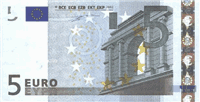 Obverse side of the 5 Euros is showing a doorway of Classical architecture. |
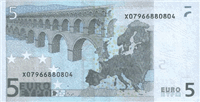 Reverse side of the 5 Euros is showing a bridge of Classical architecture. |
| 10 Euros | |
|---|---|
| Banknote of 10 Euros has dimensions 127×67 mm and main colors are bubble gum, pale pink, languid lavender and piggy pink. The printer code is positioned at 8 o’clock star. | |
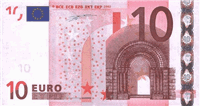 Obverse side of the 10 Euros is showing a doorway of Romanesque architecture. |
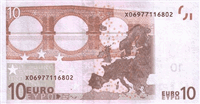 Reverse side of the 10 Euros is showing a bridge of Romanesque architecture. |
| 20 Euros | |
|---|---|
| Banknote of 20 Euros has dimensions 133×72 mm and main colors are ceil, air force blue, glaucous and pale cerulean. The printer code is positioned at 9 o’clock star. | |
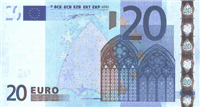 Obverse side of the 20 Euros is showing a window of Gothic architecture. |
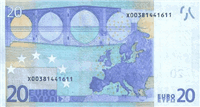 Reverse side of the 20 Euros is showing a bridge of Gothic architecture. |
| 50 Euros | |
|---|---|
| Banknote of 50 Euros has dimensions 140×77 mm and main colors are desert sand, champagne, desert sand and khaki. The printer code is positioned to the right image edge. | |
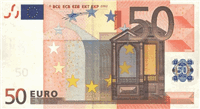 Obverse side of the 50 Euros is showing a doorway of Renaissance architecture. |
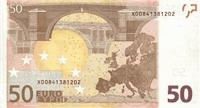 Reverse side of the 50 Euros is showing a bridge of Renaissance architecture. |
| 100 Euros | |
|---|---|
| Banknote of 100 Euros has dimensions 147×82 mm and main colors are dark sea green, dim gray, gray-asparagus and tea green. The printer code is positioned to the right of 9 o’clock star. | |
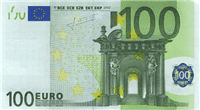 Obverse side of the 100 Euros is showing a doorway of Baroque & Rococo architecture. |
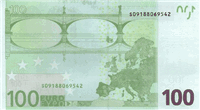 Reverse side of the 100 Euros is showing a bridge of Baroque & Rococo architecture. |
| 200 Euros | |
|---|---|
| Banknote of 200 Euros has dimensions 153×82 mm and main colors are straw, flax, pale goldenrod and ash grey. The printer code is positioned above 7 o’clock star. | |
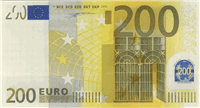 Obverse side of the 200 Euros is showing a doorway of Art Nouveau architecture. |
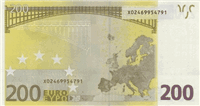 Reverse side of the 200 Euros is showing a bridge of Art Nouveau architecture. |
| 500 Euros | |
|---|---|
| Banknote of 500 Euros has dimensions 160×82 mm and main colors are lilac, mountbatten pink, pastel purple and thistle. The printer code is positioned at 9 o’clock star. | |
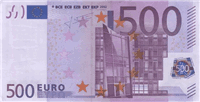 Obverse side of the 500 Euros is showing a doorway of Modern architecture. |
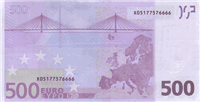 Reverse side of the 500 Euros is showing a bridge of Modern architecture. |
Useful links
- About European Central Bank:
- European Central Bank
- List of currencies:
- Currencies
- Security and design features of EUR banknotes:
- EUR banknotes
- EUR currency on Wikipedia:
- Euro
- Official Website of European Central Bank:
- www.ecb.europa.eu
- Commemorative coins:
- Commemorative Coins